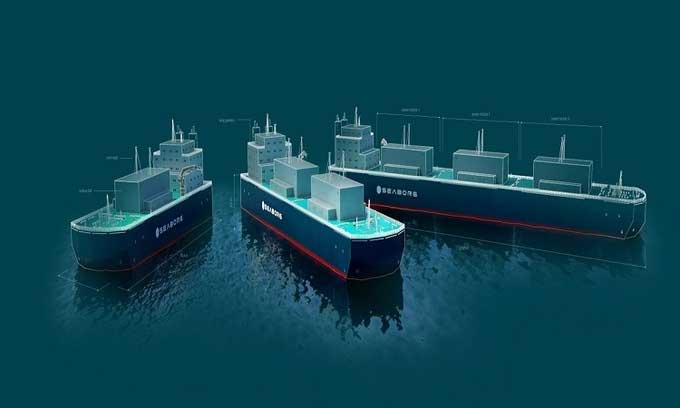Startup Seaborg Technologies in Copenhagen is embarking on the development of a new type of nuclear reactor that is affordable, mobile, flexible, and ultra-safe.
With a size comparable to a shipping container, the small molten salt reactor can be mass-produced in quantities of thousands, then placed on floating barges and deployed worldwide.

Each reactor can produce up to 200 MW of electricity and is placed on floating barges. (Photo: Seaborg Technologies).
Similar to other molten salt reactors that have existed since the 1950s, Seaborg Technologies’ product is designed to minimize the consequences of accidents. First, the reactor uses nuclear fuel mixed with fluoride salt. This mixture turns into a liquid at temperatures above 500 degrees Celsius, allowing it to flow through the reactor operating at pressures close to atmospheric pressure. The liquid salt acts as a coolant for the nuclear fuel, replacing the high-pressure water cooling used in older reactor designs. However, if this fuel comes into contact with air instead of being released as steam, it behaves like lava and solidifies into rock.
The waste produced from the reactor is radioactive but can be cleaned up. It also has low solubility in water, making it relatively safe if it falls into the ocean. Second, if the temperature exceeds control for any reason, the salt plug at the bottom of the reactor is the first to melt, immediately releasing the reactor core into a series of cooling tanks below.
Perhaps the most significant difference in Seaborg’s design is placing the reactor on floating barges offshore instead of developing nuclear power plants on land. The first advantage is the ability to produce a large number of reactors at one facility. The barges can move anywhere on the planet, mooring offshore or operating on various rivers, depending on the size of the reactor, thus eliminating the need for pre-prepared sites. The system also operates completely independently and can easily connect to the power grid.
A challenge with all molten salt reactors is corrosion. Molten salt itself is highly corrosive. This poses a significant challenge in designing all components that come into contact with the fuel salt. Placing the reactor on floating barges in seawater also exposes the reactor’s outer layer to corrosive agents. Cargo ships are typically designed to operate for 25 years due to the effects of seawater.
Other molten salt reactors use graphite as a moderator, slowing down the neutrons produced from the fission reaction. However, graphite often cracks and weakens when exposed to intense radiation and the repeated heating and cooling cycles. Seaborg’s solution is to use a different type of molten salt, sodium hydroxide, as the moderator. The fuel salt is contained within a larger tube that holds the sodium hydroxide, creating a nuclear reactor that completely uses liquid fuel. However, sodium hydroxide itself is also an extremely corrosive substance, so Seaborg needs to address this corrosive issue as well.
The large-scale prototype of the molten salt reactor is expected to be operational by 2025 off the coast of an island in Southeast Asia. Seaborg hopes to obtain design approval by 2026 and to commence mass production at a commercial scale by 2027. The reactor is small enough to fit in a shipping container, making it easy to transport and can operate for about 12 years without needing refueling.





















































